The Albanian lek (Albanian: Leku Shqiptar; plural: lekë) (sign: L; code: ALL) is the official currency of Albania. It is subdivided into 100 qindarka (singular: qindarkë), though no qindarka notes or coins are used anymore. The currency has been used since 1926.
Etymology[]
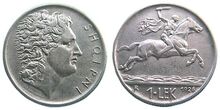
The lek may be named after Alexander the Great, who was depicted on the first lek coin.
The lek was introduced in 1926 during the reign of King Zog I (Ahmet Zogu). The lek's etymology is questioned, but there are two commonly accepted theories. Some believe the currency was named after the Macedonian conqueror, Alexander the Great, for being depicted on the obverse and reverse of the first 1 lek coin. Others state that it was named after Albanian feudal Lekë Dukagjini. The name "qindarkë" is derived from the Albanian word, qind, meaning "one hundred". Thus, the term has the same meaning as centime, cent, centesimo, euro cent, stotinka, etc.
Coins[]
First lek[]
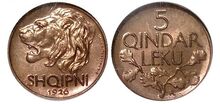
A 5 qindar leku coin from 1926.
In 1926, bronze 5 and 10 qindar lek coins were introduced, along with nickel ¼, ½, and 1 lek coins, and silver 1, 2, and 5 franga ari coins. In 1935, bronze 1 and 2 qindar ar coins were introduced, having a value equal to the 5 and 10 qindar leku coins.
After the Italian occupation of Albania, stainless steel 0.20, 0.50, 1, and 2 lek, and silver 5 and 10 lek coins were introduced, with the silver coins only issued in 1939. In 1940, aluminum-bronze 0.05 and 0.10 lek coins were introduced. These coins were issued until 1941.
In 1947, after Albania gained independence from Italy and Nazi Germany, new coins were introduced. This new series consisted of zinc ½, 1, 2, and 5 lek coins. These coins were minted once more in 1957, and were used until the currency reform of 1965.
Second lek[]
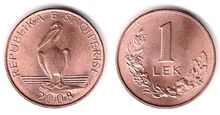
A 1 lek coin from 2008.
In 1965, aluminum coins (dated 1964) were introduced in denominations of 5, 10, 20, and 50 qindarka and 1 lek. In 1995 and 1996, a new coinage was introduced, with a bronze 1 lek coin, a nickel plated steel 5 lek coin, aluminum-bronze 10 and 20 lek coins, and a cupronickel 50 lek coin. In 2000, a bimetallic 100 lek coin was introduced.
In 2008, the 1 lek coin was changed to copper plated steel, amd in 2009, the 10 lek coin was changed to brass plated steel.
Commemorative issues[]
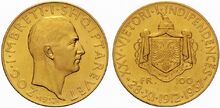
A commemorative 100 frang ar coin from 1937.
The first commemorative lek coins, denominated in 1, 2, 20, and 100 franga ari. were produced in 1937, marking the 25th anniversary of Albania's sovereignty. The following year, in 1938, two commemorative series were introduced. One, marking the 10th anniversary of the reign of King Zog I, had coins denominated in 20, 50, and 100 franga ari. The other, which commemorated Zog's marriage to Queen Geraldine, had coins denominated in 20 and 100 franga ari.
From 1968 to 1970, commemorative 100 and 500 lek coins were minted, marking the 500th anniversary of Lord Skanderbeg's death. In 1969, coins denominated in 5 and 50 qindarkë and 1 lek were produced to commemorate the 25th anniversary of Albania's liberation, and a 5 lek coin was minted to commemorate the 550th anniversary of Skanderbeg's victory over the Turks. In 1987 and 1988, a commemorative 5 lek coin was introduced, and in 1991 and 1992, commemorative 10 lek coins were introduced.
In 2001, commemorative 100 and 200 lek coins were issued under the theme of Albania's integration into the European Union, and 50, 100, and 200 lek in commemoration of the 500th anniversary of the Statue of David. A year later, in 2002, 50 and 100 lek coins were minted, marking the 100th anniversary of Albania's independence, and a 20 lek coin was minted under the Albanian Antiquity theme. In commemoration of the 100th anniversary of Girolamo de Rada's death, a 50 lek coin was produced in 2003, followed by another 50 lek coin in 2004, issued under the Albanian Antiquity theme. In 2005, a commemorative 50 lek coin was minted for the 85th anniversary of the proclamation of Tirana as Albania's capital.
Banknotes[]
First lek[]
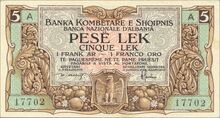
A 1 frang ar banknote.
In 1926, the National Bank of Albania introduced banknotes denominated in 1, 5, 20, and 100 franka ari. In 1939, notes denominated in 5 and 20 franga were introduced, followed by notes printed in 1944 with denominations of 2, 5, and 10 lek, and 100 franga.
In 1945, the People's Bank of Albania issued overprints of National Bank notes for 10 lek, 20 and 100 franga. Regular notes were also issued during this year in denominations of 1, 5, 20, 100, and 500 franga. During 1947, the lek was adopted as the main denomination for Albanian notes, with values of 10, 50, 100, 500, and 1000 lek. This 1947 series was later replaced by banknotes printed in 1949 and 1957.
Second lek[]
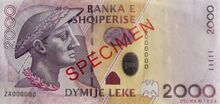
A 2000 lek banknote from 2007.
During 1965, banknotes (dated 1964) were printed by the People's Bank of Albania in denominations of 1, 3, 5, 10, 25, 50, and 100 lek. A similar series was printed in 1976, and subsequently, an undated series consisting of an 100 lek banknote, was also printed.
On June 28, 1991, notes denominated in 100 and 500 lek were introduced, and were followed by new issues on October 1, 1992, along with new 200 and 1000 lek notes. On July 11, 1997, a new series of banknotes (dated 1996) was introduced, with denominations of 100, 200, 500, 1000, and 5000 lek. The 100 lek note was demonetized on December 31, 2008. Two days prior, the 2000 lek banknote was introduced and currently circulates with the 200, 500, 1000, and 5000 lek notes.
Exchange rates[]
| Current ALL exchange rates | |
|---|---|
| From Google Finance [1]: | AUD CAD CHF EUR GBP HKD JPY USD |
| From Yahoo! Finance [2]: | AUD CAD CHF EUR GBP HKD JPY USD |
| From OzForex [3]: | AUD CAD CHF EUR GBP HKD JPY USD |
| From XE.com [4]: | AUD CAD CHF EUR GBP HKD JPY USD |
| From OANDA.com [5]: | AUD CAD CHF EUR GBP HKD JPY USD |
References[]
| Albanian lek | |
|---|---|
| Banknotes | 2 l • 1 f.a. • 5 f • 5 l • 20 f • 5 f.a. • 20 f.a. • 100 f • 100 f.a. • 500 f |
| Coins | |
| Miscellaneous | |
